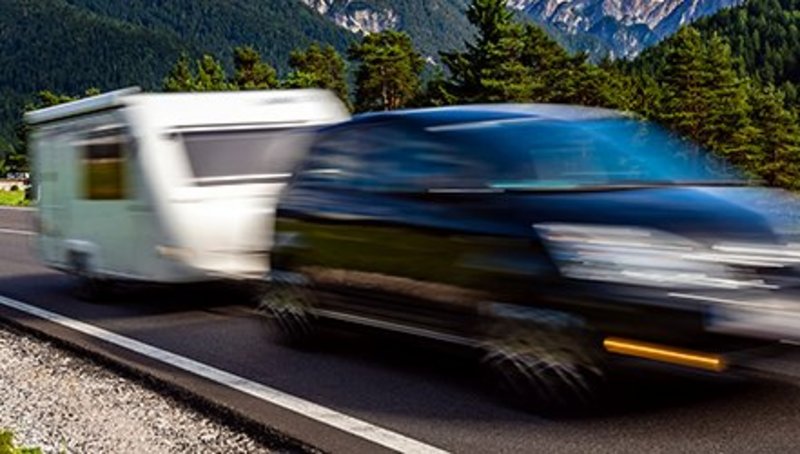
Don’t forget the Tires when you’re checking your Caravan!
Published By Continental AG [English], Tue, Jun 20, 2023 6:00 PM
Check inflation pressure and tires after the winter break
- Tires on caravans with a 100 km/h speed permit must be no more than six years old
- Don’t overload the caravan
Hanover, Germany, June 21, 2023. Before the first trip with your caravan, you should do some checks to ensure a safe start: The correct inflation pressure and the age of the tires (which must not be more than six years old for caravans registered for speeds up to 100 km/h) must be checked as well as the lighting. The overrun brake can be checked and adjusted in a workshop if there’s any doubt as to whether it’s working properly. The workshop can also check the shock absorbers on the caravan and the tow hitch to the car. When loading the caravan, the permissible total weight must not be exceeded. You’ll feel more relaxed if you’ve practiced maneuvering your caravan before you set off.
Tires – first check the correct inflation pressure and age. According to experts from tire manufacturer Continental, the tires must not be older than six years if the caravan has the 100 km/h speed permit. This approval expires when the tires are older; the maximum speed is then limited to 80 km/h. The age of a tire can be determined by the DOT marking on one of the tire sidewalls. It shows the week of manufacture in an oval field – so 3322 means that the tire was manufactured in the 33rd calendar week of 2022, i.e. last year in mid-August. The date of manufacture is decisive for the 100 km/h approval, not the date of purchase or fitting. You should also check for any visible damage to the tire, such as scuff marks on the sidewall and tread chipping or flattening. And please don’t forget to check the spare wheel. If in doubt, seek advice from a professional. One thing is crystal clear: A set of new tires is always cheaper than the consequences of one tire suddenly failing during your vacation trip – not to mention possible accident damage. Be careful, though. If you’re driving a car and a tire goes flat, you’ll often notice noises, vibrations, a warning from the tire pressure monitoring system, or a shaking steering wheel – but you won’t get any of these warnings from your trailing caravan.
One more important note about the 100 km/h speed permit: If you have a 100 km/h speed permit for your caravan, you can only drive at this speed on expressways, i.e. routes similar to highways – the maximum speed on normal country roads outside built-up areas is still 80 km/h. When driving with your caravan in other countries, you must abide by the rules there; the 100 km/h exception only applies in Germany. Other countries have different speed limits, so you should find out what they are before you start your vacation.
In contrast, testing the lighting is simple. If there are two of you, it’s easy. If you’re by yourself, it goes like this: Carefully reverse car and caravan backwards to a wall in the winter parking hall or in the shadow. In your rear-view mirror – and don’t forget to adjust it beforehand! – you can easily see the brake light and the reversing light. You might have to get out of the car to see for sure. The engine should be switched off, the parking brake applied, a gear engaged or the automatic selector lever set to “P”.
If you have a used caravan, or a new caravan but an older car, you may have seven-pin electric couplers. To connect these to the 13-pin connectors that have been in use since 2011, adapters are available from specialist retailers, so you don’t have to do any alterations yourself. If a lamp has failed, you can tell by the filament if the lamp is faulty. If the filament’s OK, contact spray on all connections often helps to eliminate the problem.
The individual total weights of the caravan and of the towing vehicle and the entire combination must not be exceeded. The permitted payloads can be found in the vehicle’s registration certificate. The weight that can be supported can be found on a sticker on the car’s tow hitch, in the trunk or in the owner’s manual.
A caravan literally invites you to use its generous inside space. However, the payload is limited – and it’s further reduced by attachments and fixtures such as awnings, water tank, gas bottles, utility batteries and the rear carrier with bicycles. Your camping table and chairs also want to be taken along. And you don’t want to leave any of your supplies at home either. Special caravan scales, available as accessories, help to determine the total weight. This will help you avoid overloading. In a caravan, it’s best to stow heavy items in the center, where they won’t slip, and as low as possible. This will keep the vehicle’s handling balanced.
When determining the load on the tow hitch, special tow hitch scales from a specialist dealer will help; it should be relatively close to the hitch’s rated load to ensure high driving stability. If you’re unsure whether or not the vehicle is too heavy, you should go to a vehicle scale, the locations of which can be found on the Internet. In Lower Saxony alone, there are almost 140 such scales. As a general rule, it’s better to leave at home anything you’re unlikely to need or can buy at your destination, such as food.
Continental Presse Tires EMEA
Continental Reifen Deutschland GmbH
Press release distributed by Wire Association on behalf of Continental AG, on Jun 20, 2023. For more information subscribe and follow Continental AG